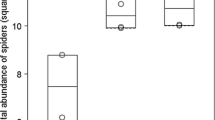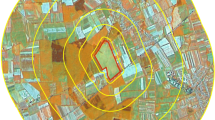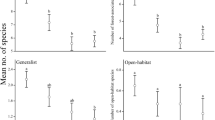Summary
Species composition and diversity of a guild of wandering spiders was studied by pitfall trapping over an elevational gradient in an Illinois streamside forest. Differences in flooding frequency and their effect on the litter habitat (removal and/or compression) account for a majority of the variation in the number of species between elevations. Changes in spider communities with elevation over the flooding gradient are indicative of a transition from a harsh to a moderate environment: (1) increased abundance and species diversity; (2) decreased dominance of flood tolerant species accompanied by increased dominance of species with specialized microhabitats found in complex litter; (3) greater similarity in species composition between sites; and, (4) a change in species-abundance curves from a geometric series to a lognormal distribution. The influence of the flooding regime in regulating community structure of spiders is discussed. A multiple regression equation including flood frequency and litter depth as variables was used to predict the impact of altered flooding regimes (due to reservoir construction downstream) on spider diversity.
Similar content being viewed by others
References
Bell, D. T.: Tree stratum composition and distribution in the streamside forest. Amer. Midl. Natur. 92, 35–46, (1974)
Bell, D. T.: Studies on the ecology of a streamside forest: composition and distribution of vegetation beneath the tree canopy. Bull. Torrey Bot. Club. 101, 14–20 (1974)
Bell, D. T., Sipp, S. K.: The litter stratum in the streamside forest ecosystem. Oikos (in press, 1975)
Berry, J. W.: The distributional ecology of spiders in the old-field succession of the Piedmont region of North Carolina. Ph. D. thesis, Duke University, Durham, N. C. (1967)
Edgar, W. D.: Prey and predators of the wolf spider, Lycosa lugubris. J. Zool. (Lond.) 159, 405–411 (1969)
Fitch, H. S.: Spiders of the University of Kansas natural History Reservation and Rockefeller Exp. tract. Univ. Kansas Mus. Nat. Hist. Publ. 33, 1–202 (1963)
Jocque, R.: The spider fauna of adjacent woodland areas with different humus types. Biol. Jaarboeck 41, 153–179 (1973)
Kaston, B. J.: Spiders of Connecticut. Conn. State Geol. and Natur. Hist. Survey Bull. 70, 1–874 (1948)
Lowrie, D. L.: The ecological succession of spiders of the Chicago area dunes. Ecology 29, 334–351 (1948)
Moulder, B. C., Reichle, D. E.: Significance of spider predation in the energy dynamics of forest arthropod communities. Ecol. Monogr. 42, 473–498, (1972)
Norton, R. A.: Ecology of soil and litter spiders. Proc. Soil Microcommunities Conf. 1, 138–156, (1973)
Paine, R. T.: Food web complexity and species diversity. Amer. Natur. 100, 65–75 (1966)
Pianka, E. R.: Evolutionary ecology, 356 pp. New York: Harper and Row 1974
Pimentel, D.: Species diversity and insect pest outbreaks. Ann. Ent. Soc. Amer. 54, 76–85 (1961)
Preston, F. W.: The commonness, and rarity, of species. Ecology 29, 254–283 (1948)
Root, R. B.: Organization of a plant arthropod association in simple and diverse habitats: the fauna of Collards (Brassica oleracea). Ecol. Monogr. 43, 95–124 (1973)
Shannon, C. E.: A mathematical theory of communication. Bell Inst. Tech. J. 27, 379–423; 623–656 (1948)
Sneath, P. H. A., Sokal, R. R.: Numerical taxonomy, 573 pp. San Francisco: Freeman 1973
Sorenson, T.: A method of establishing groups of equal amplitude in plant society based on similarity of species content. K. Danske Vidensk. Selsk. 5, 1–34 (1948)
Sudd, J. H.: The distribution of spiders at spurn Head (E. Yorkshire) in relation to flooding. J. anim. Ecol. 41, 63–70, (1972)
Turnbull, A. L.: A population of spiders and their potential prey in an overgrazed pasture in Eastern Ontario. Canad. J. Zool. 44, 557–583 (1966)
Uetz, G. W.: Temporal and spatial variation in spider species diversity. Environ. Entomol. 4, 719–724 (1975a)
Uetz, G. W.: Coexistence in a guild of wandering spiders (in review). (1975b)
Uetz, G. W., Unzicker, J. D.: Pitfall trapping in ecological studies of wandering spiders. J. Arachnol. 3 (in press, 1975)
Weins, J. A.: Pattern and process in grassland bird communities. Ecol. Monogr. 43, 237–270 (1973)
Whittaker, R. H.: Dominance and diversity in land plant communities. Science 147, 250–260 (1965)
Whittaker, R. H.: Evolution and measurement of species diversity. Taxon. 21, 213–251 (1972)
Whittaker, R. H.: Communities and ecosystems, 2nd ed., 387 pp. New York: Macmillan 1975
Author information
Authors and Affiliations
Rights and permissions
About this article
Cite this article
Uetz, G.W. Gradient analysis of spider communities in a streamside forest. Oecologia 22, 373–385 (1976). https://doi.org/10.1007/BF00345314
Received:
Issue Date:
DOI: https://doi.org/10.1007/BF00345314




